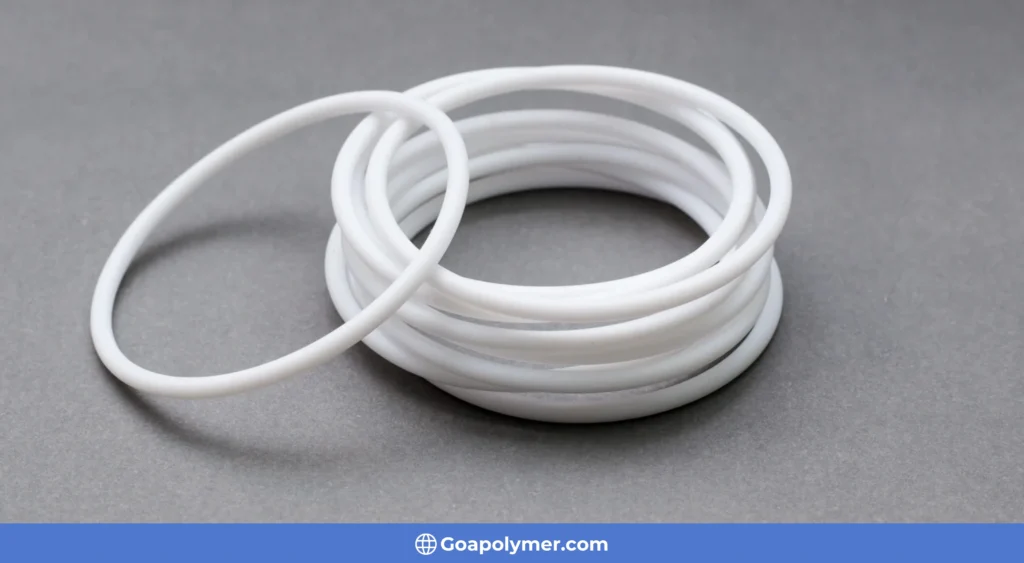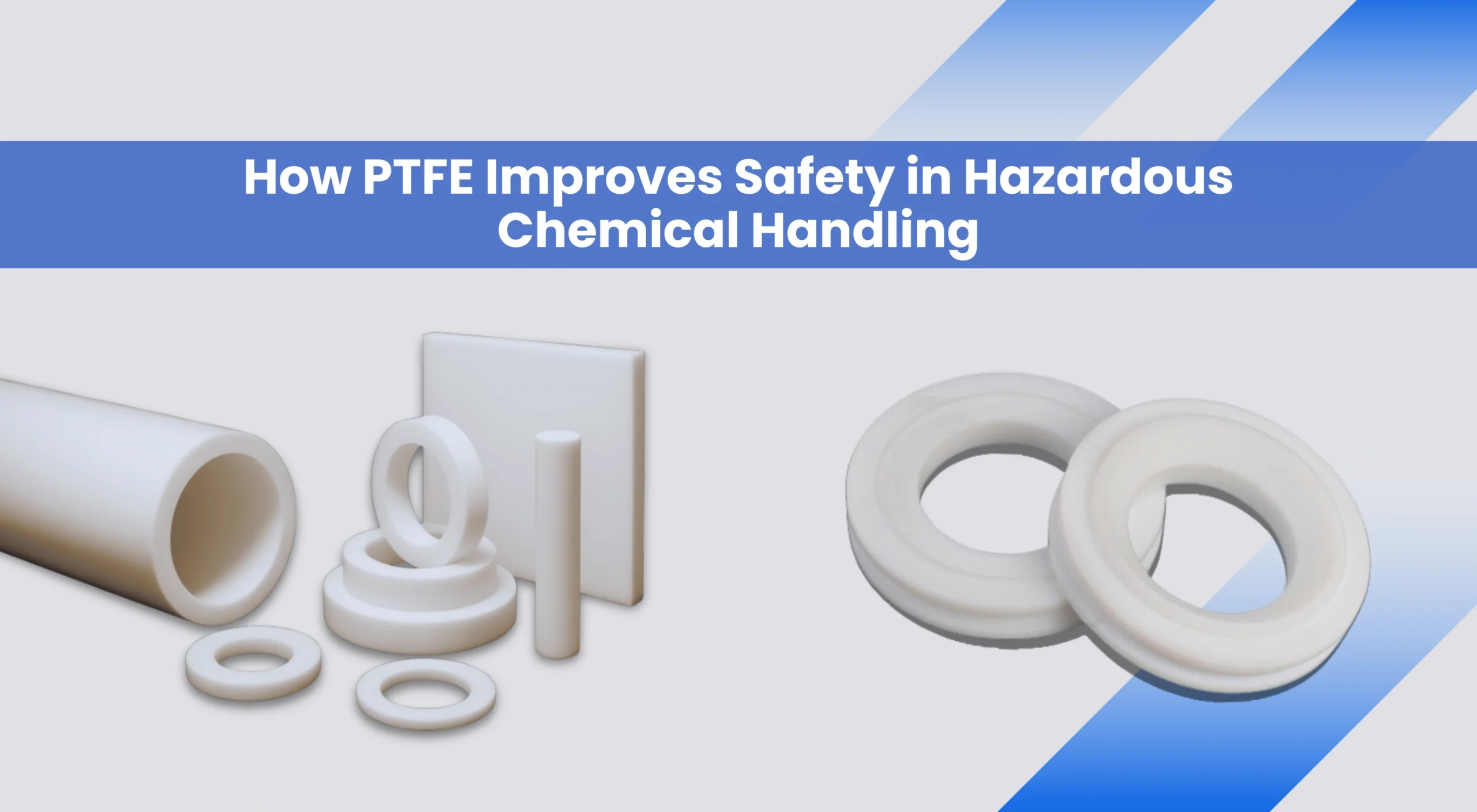Handling hazardous chemicals poses numerous risks to workplace safety. The project requires proper organization and suitable resources for achievement. A small leak or any spill, or chemical reaction can cause a major accident to occur. The situation could harm employees and damage company equipment. The materials need to be both strong and durable because they must resist corrosion. PTFE is the main material for chemical handling. This is because it contains polytetrafluoroethylene. PTFE is a unique plastic. The substance remains unaltered when it encounters most chemical substances. The PTFE works well in extreme heat and cold. The non-stick surface prevents any form of chemical buildup from occurring. PTFE works well for hoses, seals, gaskets, tanks, and equipment in chemical industries. In this blog, we’ll explain how PTFE helps with safe equipment handling. It also reduces risks when working with hazardous chemicals. Then we will explain why PTFE is used globally for safe chemical handling. Contact Us for Custom PTFE Washer Solutions – Built for Safety & Durability.
Why is chemical resistance important?
The main priority when working with dangerous chemicals is testing for chemical resistance. Chemical resistance matters. Without it, equipment, containers, and hoses can break down. The situation creates conditions that can lead to chemical leaks, hazardous reactions, and spills.
Workers maintain protection through the use of chemically resistant materials, including PTFE. The protective system shields the equipment from damage. The system runs this way to keep chemical operations going nonstop.
Benefits of Chemical Resistance in PTFE:
- Prevent corrosion: PTFE functions as a protective barrier against chemical reactions, which extends the operational lifespan of equipment.
- Prevent leaks and spills: The materials that resist chemicals maintain their strength during severe environmental conditions.
- Protects workers: The reduction of chemical and spill exposure leads to improved safety standards for employees in their workplace.
- Lower maintenance: Equipment remains operational without frequent replacement or repair because chemical damage does not occur.
- Ensures process safety: Stable materials prevent unexpected reactions in chemical processes.
How PTFE Improves Safety in Hazardous Chemical Handling
PTFE is widely used in the chemical industry. The PTFE demonstrates a high level of effectiveness in handling dangerous chemicals. The following are how PTFE ensures safety:
1. Prevents Chemical Damage
PTFE resists acids, bases, solvents, and many corrosive chemicals. The protective barrier keeps dangerous substances from breaking down. It also stops them from interacting with nearby materials. PTFE stops chemical damage. The system protects hoses, gaskets, seals, and containers. The system keeps a secure environment. This reduces the risk of leaks and accidents.
2. Reduces Leak Risks
Leaks pose serious risks during chemical handling. They can cause dangerous spills and direct exposure to harmful chemicals. The material PTFE shows excellent resistance to chemicals and heat. The system protects all components from damage during extreme operational conditions. The system has leak prevention measures. These keep employees and the environment safe from harm.
3. Ensures Thermal Stability
The thermal stability of PTFE prevents equipment from experiencing deformation or melting. The system prevents toxic gases from leaking out into the atmosphere. The chemicals create dangerous fumes that appear when people handle substances.
4. Minimizes Maintenance and Downtime
PTFE functions as a durable substance that provides non-stick characteristics. The protection system guards against equipment damage, chemical accumulation, and corrosion. Equipment needs less cleaning, repair, and replacement. The design helps save costs and time. The system protects employees from dangerous substances during maintenance activities.
5. Protects Workers and the Environment
PTFE serves to block leaks, chemical reactions, and equipment breakdowns. The system also stops workers from direct exposure to hazardous substances. The environment suffers damage when chemical spills occur. PTFE implementation creates safer workplaces, which also protect the environment through sustainable practices. The system reduces the risk of spills.
6. Enhances Equipment Longevity
The PTFE coating increases the life of industrial equipment. Hoses, seals, gaskets, and tank linings made with PTFE last a long time. Organizations keep safety standards by using reliable equipment. This helps protect workers during chemical handling.

How PTFE Resists Temperature?
Temperature is one of the major issues in handling hazardous chemicals. Scientists must heat chemicals to very high temperatures or cool them to very low temperatures. Materials react to temperature changes in different ways. Some melt, others crack, and some release harmful gases. PTFE refers to a material that remains stable at high temperatures. It is strong and safe to use across a wide temperature range.- High heat resistance: PTFE remains stable at high temperatures. The material keeps its stability during extended operations, which reach temperatures near 260 °C. The material functions effectively in thermal and chemical treatment operations because of its special design.
- Cold resistance: PTFE stays flexible and dependable at temperatures down to −70 °C. The material functions effectively in cryogenic operations and cold chemical procedures because of its special design.
- Safety under stress: PTFE maintains its strength while resisting heat exposure, which sets it apart from various plastic materials. The system includes a protection mechanism that decreases the chance of leaks or system breakdowns.
Where is PTFE used for Safety?
People see PTFE industries as hazardous chemical sectors. But they also focus on reducing risks to people and their equipment. It includes chemical resistance, heat resistance, and anti-stick properties. These features suit various applications. The association of PTFE states the safety-enhancing fields below:- Hoses and Tubing: PTFE hoses and tubing safely transport liquids and gases. The PTFE is impervious to strong acids, bases, and solvents, unlike ordinary materials. This cuts down on leakage accidents. It also lets other chemicals flow smoothly under pressure and with temperature changes.
- Tank and Vessel Linings: These tanks have linings to protect large tanks and chemical vessels from corrosive chemicals that can damage metal surfaces. The lining creates a barrier to protect the tanks. It keeps them safe from contamination and ensures proper alignment.
- Seals and Gaskets: Seals and gaskets prevent leakages in pipelines or containers. PTFE gaskets are very reliable. They resist chemicals well and stay stable under pressure and temperature changes. This change will guarantee a tight seal and safe handling of chemicals.
- Valves and Fittings: PTFE in valves and fittings keeps operations smooth because of low friction. For such parts that have to resist corrosion, this is an assurance that they will not give way to failure. This supports reliable chemical flow without blockage or damage risks.
- Bearings and Moving Parts: Manufacturers apply PTFE to produce bearings and moving components for chemical equipment. The system runs at peak efficiency, preventing equipment failure. This avoids chemical spills and accidents.



